JAVA process control method
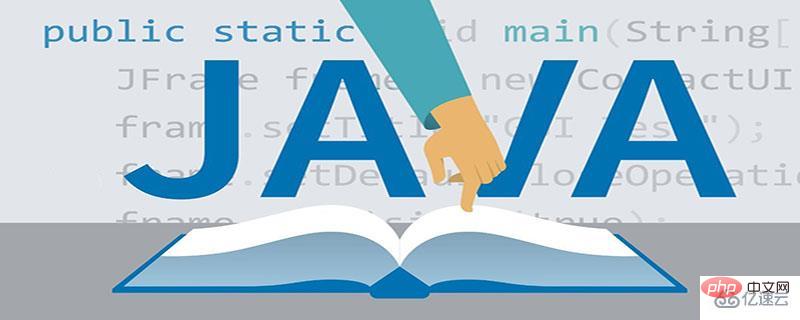
JAVA input and output
Input
Two input methods:
Method 1: java.util.Scanner
The code is as follows:
public class a {
public static void main(String[] args) {
var sc = new Scanner(System.in);
System.out.println("请输入姓名:");
String name = sc.nextLine();
System.out.printf("%n欢迎你:%s", name);
}}Generate a Scanner object, output "Please enter your name:", return the input string and assign a value For name, output "%nWelcome %s" where %n means line break %s means name
Result: 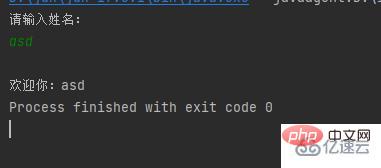
Method 2: JOptionPane input content If it is determined, it will be a string value. As long as it is not determined, it will be null
public class a {
public static void main(String[] args) {
String w = JOptionPane.showInputDialog("请输入词汇:");
System.out.println(w);
}} Result: 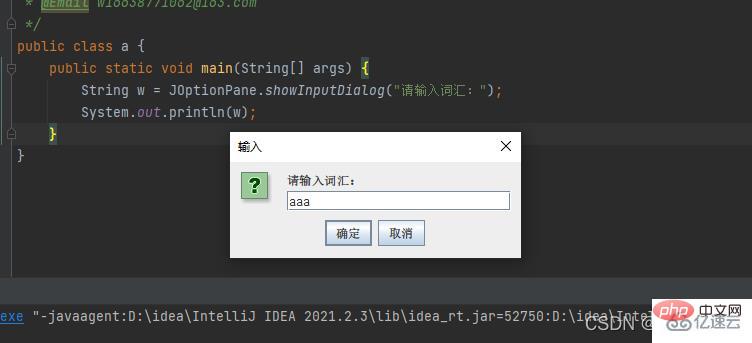

Output
Three ways to output on the console
Method one: System.out.print(); Output to the console
Method two: System.out.println(); Output to the console and wrap
Method three: System.out.printf(); format output to the console
Code demonstration:
The first method does not have newlines Direct output
public class a {
public static void main(String[] args) {
int w = 1;
int a = 2;
System.out.print(w);
System.out.print(a);
}}Result:
Second line break output
public class a {
public static void main(String[] args) {
int w = 1;
int a = 2;
System.out.println(w);
System.out.println(a);
}}Result:
The third formatted output
%d means an int type variable, that is, replacing the first %d with the value of w, and replacing the second %d with the value of a
public class a {
public static void main(String[] args) {
int w = 1;
int a = 2;
System.out.printf("w=%d a=%d", w, a);
}}Result: 
Branch statement
if else
if() As long as the conditions in brackets are correct It returns true, if it is wrong, it returns false
else means otherwise
public class a {
public static void main(String[] args) {
if (1>2){
System.out.println("A");
}else {
System.out.println("B");
}
}}Multiple judgments are as follows: if the first judgment is not correct, proceed to the next judgment. When the return value is It is executed when true, otherwise it is executed else
public class a {
public static void main(String[] args) {
if (1 > 2) {
System.out.println("A");
} else if (1 > 0) {
System.out.println("B");
} else {
System.out.println("C");
}
}}switch case default
switch multi-branch switch statement
switch(w) w in brackets is the judgment parameter, after case The number is the value that matches w. When the value of w matches the value after the case, the statement in the current case is executed
break means to exit the current judgment, which means that there is no need to judge again later
default means the default value, when there is no match The default is this
public class a {
public static void main(String[] args) {
int w=1;
String wk = "";
switch (w) {
case 2:
wk = "星期一";
break;
case 3:
wk = "星期二";
break;
case 4:
wk = "星期三";
break;
case 5:
wk = "星期四";
break;
case 6:
wk = "星期五";
break;
case 7:
wk = "星期六";
break;
default:
wk = "星期日";
break;
}
System.out.println(wk);
}} result: 
Loop statement
for
for ( int i = 0; i < 5; i ) is divided into three parts. int i=0 is the initial value, i<5 is the loop condition, and i is the value of i plus 1 after executing this statement once. Exit the loop when i>5
public class a {
public static void main(String[] args) {
for (int i = 0; i < 5; i++) {
System.out.println(i);
}
}} Result: 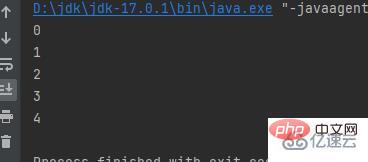
for in
for in is mainly used to loop collections Or an array, use an array to demonstrate
public class a {
public static void main(String[] args) {
int[] a = {1, 2, 3, 4, 5};
for (int i : a) {
System.out.println(i);
}
}}i corresponds to the value in the table below of array a, which is equivalent to looping output a[0],a[1]a[2],a [3]The value of a[4]
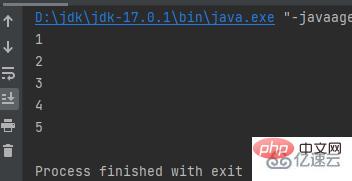
while do while
while(condition){ }
Execute the statement if the condition is met, exit if not.
public class a {
public static void main(String[] args) {
int i = 0;
while (i < 5) {
i++;
System.out.println(i);
}
}} Result: 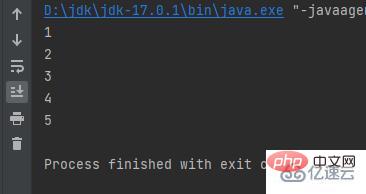
do while
Different from while, do while is executed once Then judge
public class a {
public static void main(String[] args) {
int i = 0;
do {
i++;
System.out.println(i);
} while (i < 0);
}}The output is executed first and then judged. Therefore, the condition i<0 can also output once
The result is:
break continue
break; Terminate the current loop statement
continue; End this loop and immediately prepare to start the next loop
int i = 0;while (++i < 20) {
if (i % 2 == 0) continue;
System.out.println(i);
if (i > 10) break;}Skip this time when i is divisible by 2 , proceed to the next cycle. When i is greater than 10, the loop ends.
The above is the detailed content of JAVA process control method. For more information, please follow other related articles on the PHP Chinese website!

Hot AI Tools

Undresser.AI Undress
AI-powered app for creating realistic nude photos

AI Clothes Remover
Online AI tool for removing clothes from photos.

Undress AI Tool
Undress images for free

Clothoff.io
AI clothes remover

AI Hentai Generator
Generate AI Hentai for free.

Hot Article

Hot Tools

Notepad++7.3.1
Easy-to-use and free code editor

SublimeText3 Chinese version
Chinese version, very easy to use

Zend Studio 13.0.1
Powerful PHP integrated development environment

Dreamweaver CS6
Visual web development tools

SublimeText3 Mac version
God-level code editing software (SublimeText3)

Hot Topics
 Square Root in Java
Aug 30, 2024 pm 04:26 PM
Square Root in Java
Aug 30, 2024 pm 04:26 PM
Guide to Square Root in Java. Here we discuss how Square Root works in Java with example and its code implementation respectively.
 Perfect Number in Java
Aug 30, 2024 pm 04:28 PM
Perfect Number in Java
Aug 30, 2024 pm 04:28 PM
Guide to Perfect Number in Java. Here we discuss the Definition, How to check Perfect number in Java?, examples with code implementation.
 Random Number Generator in Java
Aug 30, 2024 pm 04:27 PM
Random Number Generator in Java
Aug 30, 2024 pm 04:27 PM
Guide to Random Number Generator in Java. Here we discuss Functions in Java with examples and two different Generators with ther examples.
 Weka in Java
Aug 30, 2024 pm 04:28 PM
Weka in Java
Aug 30, 2024 pm 04:28 PM
Guide to Weka in Java. Here we discuss the Introduction, how to use weka java, the type of platform, and advantages with examples.
 Armstrong Number in Java
Aug 30, 2024 pm 04:26 PM
Armstrong Number in Java
Aug 30, 2024 pm 04:26 PM
Guide to the Armstrong Number in Java. Here we discuss an introduction to Armstrong's number in java along with some of the code.
 Smith Number in Java
Aug 30, 2024 pm 04:28 PM
Smith Number in Java
Aug 30, 2024 pm 04:28 PM
Guide to Smith Number in Java. Here we discuss the Definition, How to check smith number in Java? example with code implementation.
 Java Spring Interview Questions
Aug 30, 2024 pm 04:29 PM
Java Spring Interview Questions
Aug 30, 2024 pm 04:29 PM
In this article, we have kept the most asked Java Spring Interview Questions with their detailed answers. So that you can crack the interview.
 Break or return from Java 8 stream forEach?
Feb 07, 2025 pm 12:09 PM
Break or return from Java 8 stream forEach?
Feb 07, 2025 pm 12:09 PM
Java 8 introduces the Stream API, providing a powerful and expressive way to process data collections. However, a common question when using Stream is: How to break or return from a forEach operation? Traditional loops allow for early interruption or return, but Stream's forEach method does not directly support this method. This article will explain the reasons and explore alternative methods for implementing premature termination in Stream processing systems. Further reading: Java Stream API improvements Understand Stream forEach The forEach method is a terminal operation that performs one operation on each element in the Stream. Its design intention is






